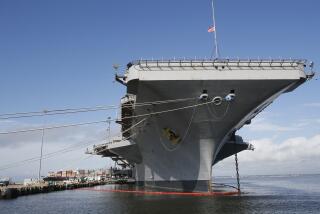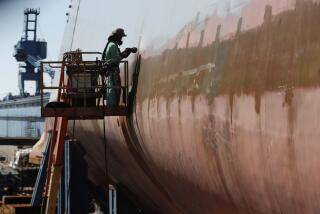Iran Air Incident: Is Training Adequate?
- Share via
WASHINGTON — The failure of the men in the command center of the Navy cruiser Vincennes to accurately interpret data from the ship’s Aegis radar system raises troubling questions about whether sailors and officers are adequately trained to use the Navy’s complex and sophisticated new war-making machines.
A Navy investigative team, in a report still not made public, attributed the Vincennes’ decision to shoot down a civilian Iran Air jetliner on July 3 to a case of the jitters brought on by a gun battle with Iranian speedboats that had occurred minutes before.
Although the sailors aboard the Vincennes had undergone a full year of training with the Aegis radar system, including simulated combat, they had never faced the psychological pressure of battle, and some experts wonder whether Navy training adequately prepares sailors to deal with the real thing.
“There was an error in judgment (that) may indicate a need for additional training in some areas,” Sen. John McCain (R-Ariz.) said. “When the technology breaks down, it is often because of human error.”
Officials have said the crew of the Vincennes went through extensive preparation exercises for their mission before the ship arrived in the Persian Gulf to join the naval force protecting commercial shipping there.
The drills included a simulation of the approach of a hostile aircraft in skies also occupied by commercial flights.
Nevertheless, the approximately 35-man crew in the ship’s Combat Information Center was young and inexperienced in combat, the investigators determined. Such a crew ranges in age from 18 to 30 and in educational background from high school to graduate school.
System’s ‘Heart and Soul’
The sailor who operates the SPY-1 radar, called the “heart and soul” of the Aegis system, is typically a 21-year-old petty officer, while the ship’s tactical action officer is generally about 27, said one former Aegis system commander. The Vincennes’ tactical action officer has been named a party to the investigation along with ship Capt. Will C. Rogers III.
“It gets pretty puckery out there,” said a naval officer who recently served as the skipper of an Aegis cruiser in the gulf. “You can’t compare that kind of stress to driving an 18-wheeler.”
While the officer called the men who served under him “smart and enthusiastic,” he added that the Navy’s primary preoccupation with a World War III-style clash against the Soviet Union has not prepared sailors well for duty in the Persian Gulf, where potential aggressors mingle with peaceful commercial traffic.
According to the airline incident investigation, the ship’s command center crew apparently misread the Aegis system’s digital presentation on the airliner after it took off from the Iranian port of Bandar Abbas. While the slow-moving aircraft was flying level in a commercial air corridor, the crew, unnerved by the earlier naval clash, incorrectly concluded it was a speeding fighter jet descending toward the ship.
They failed to heed evidence that would have suggested otherwise, the panel has determined, and gave Rogers the faulty information that prompted him to order that missiles be fired at the craft.
A General Accounting Office report released last week complained that the kind of stress training that could prepare Aegis operators to perform well under such fire also has been missing from operational tests of the system.
“The GAO report was quite clear,” said Rep. Denny Smith (R-Ore.). “The ships’ crews have never been stressed realistically during operational tests. The tests have been success-oriented from the standpoint of testing the equipment and the crew.”
Defense watchdogs say it could take years before a change in test practices could prepare crews like those aboard the Vincennes for real combat situations.
More to Read
Sign up for Essential California
The most important California stories and recommendations in your inbox every morning.
You may occasionally receive promotional content from the Los Angeles Times.














